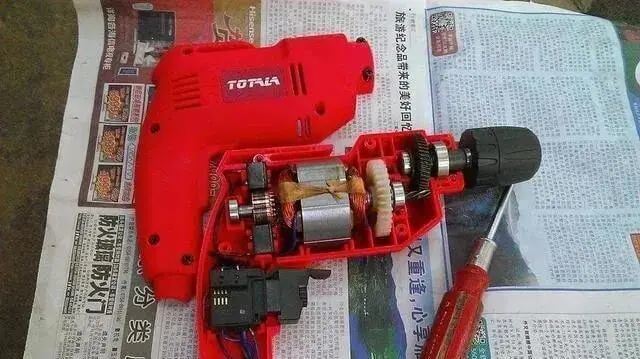ページの内容
トグルなぜパワーツールはブラシレスモーターの代わりにブラシ付きモーターを使用するのですか??
なぜ電動工具があるのか (ハンドドリルなど, 角度グラインダー, 等) 通常、ブラシレスモーターの代わりにブラシモーターを使用します? 理解するために, これは、文では本当に明らかではありません.

DCモーター ブラシモーターとブラシレスモーターに分かれています, そして “ブラシ” ここで言及されているのは、カーボンブラシを指します. カーボンブラシはどのように見えますか?

なぜそうする DCモーター カーボンブラシが必要です? カーボンブラシとカーボンブラシの違いは何ですか? 読んでみましょう!
DCブラシモーターの原理
図に示すように 1, これはDCブラシモーター構造モデルです. 2つの固定異方性磁石, コイルの真ん中に配置されます, コイルの端は2つの半円形の銅リングに接続されていました, 銅リングの端と固定カーボンブラシの接触, そして、カーボンブラシの端にDC電源に接続されていました.

形 1
電源が接続された後, 電流は、図の矢印で示されているとおりです 1. 左側のルールによると, 黄色のコイルは垂直方向の上向きの電磁力にさらされます; 青いコイルは垂直方向の下向きの電磁力を受けます. モーターローターは時計回りに回転し始めます 90 回転度, 図に示すように 2.

形 2
現時点では, カーボンブラシは、2つの銅リングの間のギャップの真ん中にあります, コイル回路全体に電流はありません. しかし、慣性の作用の下で, ローターはまだ回転し続けています.

形 3
ローターが慣性の下で上記の位置に変わるとき, コイル電流を図に示します 3. 左側のルールによると, 青いコイルは、垂直方向の上向きの電磁力にさらされます; 黄色のコイルは垂直方向の下向きの電磁力を受けます. モーターローターは時計回りに回転し続けます, 後 90 学位, 図に示すように 4: 現時点では, カーボンブラシは、2つの銅リングの間の真ん中の隙間にあります, コイル回路全体に電流はありません. しかし、慣性の作用の下で, ローターはまだ回転し続けています. その後、上記の手順が繰り返されます, そして、サイクルは続きます.
ブラシレス DC モーター
図に示すように 5, これはDCブラシレスモーター構造のモデル図です. ステーターとローターで構成されています, ここで、ローターには磁性極があります; ステーターには、多くのコイルが巻かれています, 6セットのコイルが図に示されています.

形 5
電流をステーターコイルに渡すとき 2 と 5, コイル 2 と 5 磁場が生成されます, ステーターはバーの磁石に相当します, どこ 2 sです (南) ポールと 5 nです (北) ポール. 同性の極が互いに引き付けるので, ローターNポールはコイルに回転します 2 位置とローターSポールはコイルに回転します 5 位置, 形 6.

形 6
次に、ステーターコイルから電流を引き出します 2 と 5 電流をステーターコイルに渡します 3 と 6. 現時点では, コイル 3 と 6 磁場が生成されます, ステーターはバーの磁石に相当します, どこ 3 sです (南) ポールと 6 nです (北) ポール. 同性の磁気極が互いに引き付けるので, ローターNポールはコイルに回転します 3 位置とローターSポールはコイルに回転します 6 位置, 形 7.

形 7
同様に, 次に、ステーターコイルから電流を取り外します 3 と 6, そして、電流をステーターコイルに渡します 4 と 1. 現時点では, コイル 4 と 1 磁場が生成されます, ステーターはバーの磁石に相当します, どこ 4 sです (南) ポールと 1 nです (北) ポール. 反対側の極が互いに引き付けるので, ローターNポールはコイルに回転します 4 位置とローターSポールはコイルに回転します 1 位置. まで
この時点まで, モーターは半ターンを回転させました …. 後半のターンは前の原則と同じです, したがって、ここでは繰り返しません. DCブラシレスモーターは、ロバの前でにんじんを釣るようなものであるように理解することができます, ロバがニンジンに向かって動き続けるように.

では、異なる瞬間に正確な電流を異なるコイルに渡すにはどうすればよいですか? これには、現在の整流回路が必要です …… ここでは詳しく説明しません.
ブラシDCモーターとブラシレスDCモーターの利点と短所比較
DCブラシモーター: 高速開始, タイムリーなブレーキ, 滑らかな速度規制, 単純なコントロール, シンプルな構造, 安い. ポイントは、価格が安いということです! 価格は安いです! 価格は安いです! そして、それは高い開始電流を持っています, 高トルク (回転力) 低速で, 非常に重い負荷を運ぶことができます.
しかし, カーボンブラシと整流子の間の摩擦のため, DCブラシモーターはスパークを簡単に生成できます, 熱, ノイズ, 外部環境への電磁干渉, そして、効率が低く短い人生. カーボンブラシは摩耗と涙製品だから, 失敗するのは簡単です, 一定期間後に交換する必要があります.

DCブラシレスモーター: DCブラシレスモーターはカーボンブラシを排除するためです, したがって、ノイズは小さいです, メンテナンスなし, 低障害率, 長寿命, そして、実行時間と電圧はより安定しています, 無線機器の干渉が小さいため. しかし、それは高価です! 高い! 高い!
電動工具は、人生において非常に一般的なツールです, そして、さまざまなブランドと激しい競争があります, したがって、人々は価格に非常に敏感です. そして、非常に重い負荷を運ぶために必要な電動工具, 多くの開始トルクである必要があります, ハンドドリルなど, インパクトドリル. さもないと, 掘削するとき, ドリルビットがスタックしているため、モーターは簡単に実行できません.

低価格のブラシDCモーターを想像してください, 高い開始トルクと重い負荷を運ぶことができます; ブラシレスモーターの故障率は低く、寿命が長いです, しかし、それは高価であり、開始トルクはブラシモーターよりもはるかに少ないです. 選択した場合, どのように選びますか, 答えは自明だと思います.



